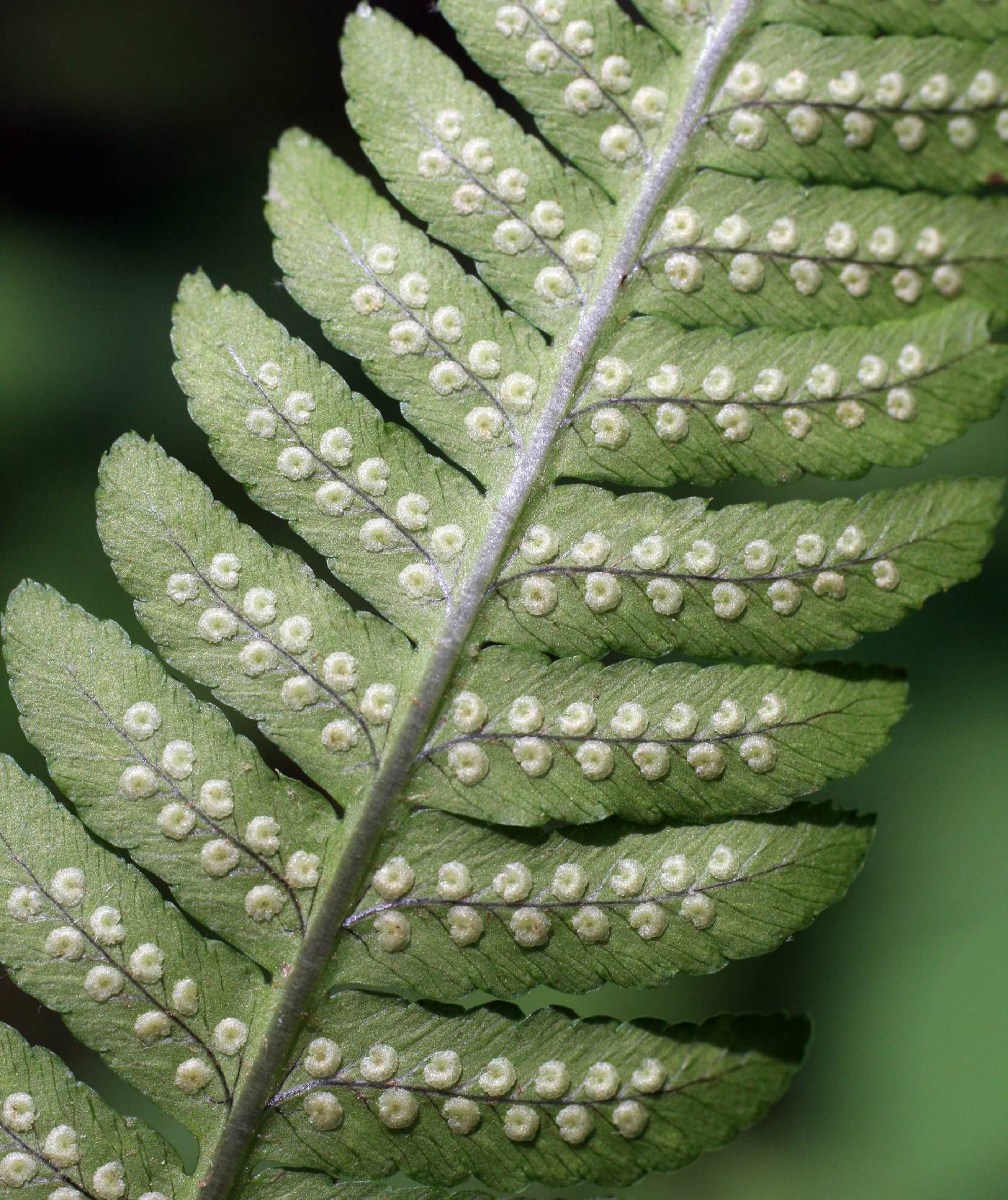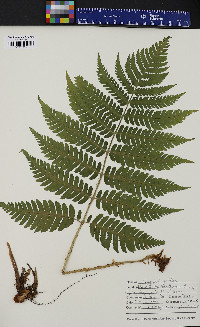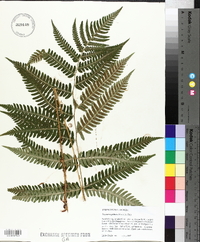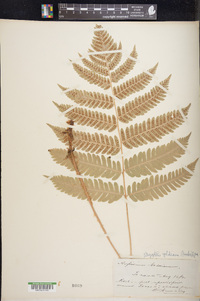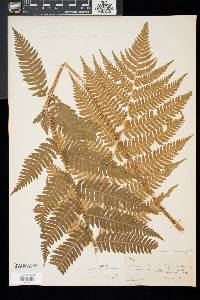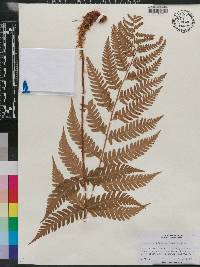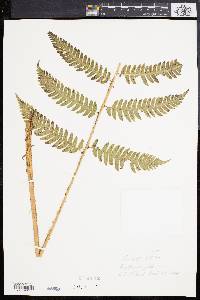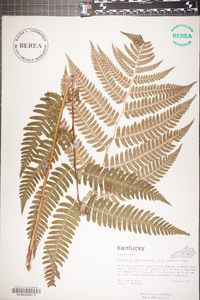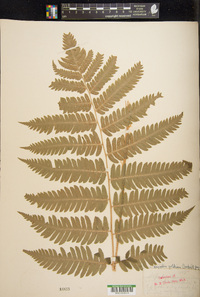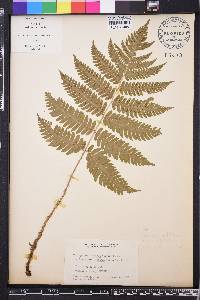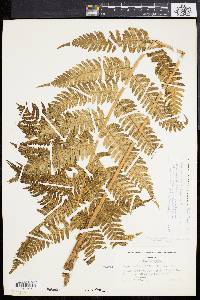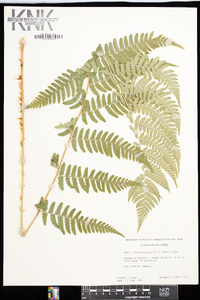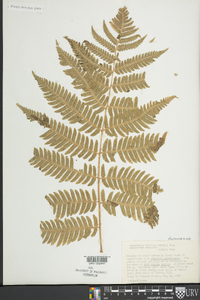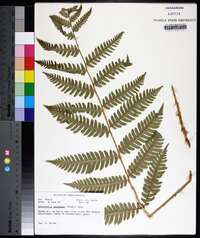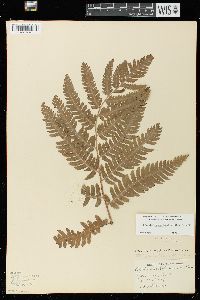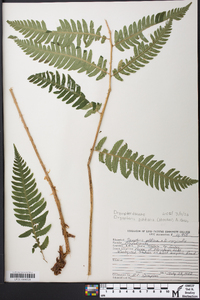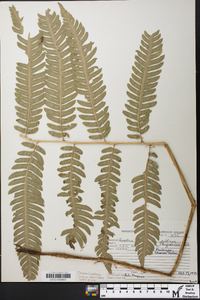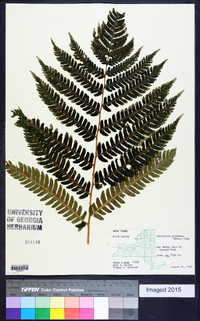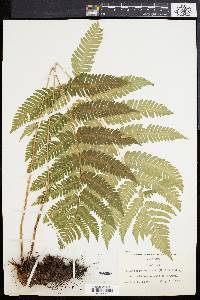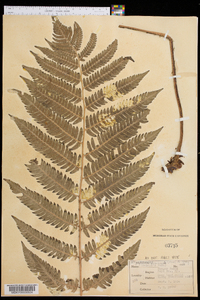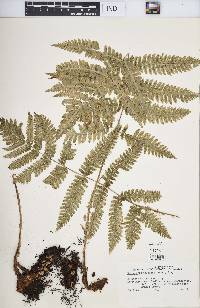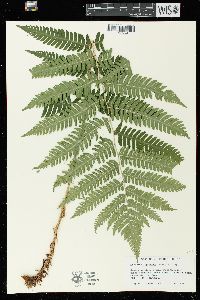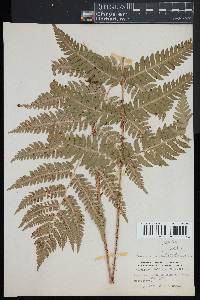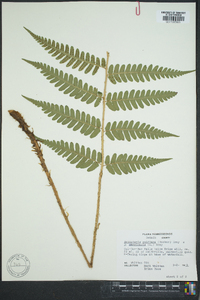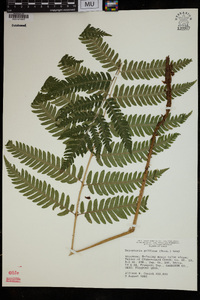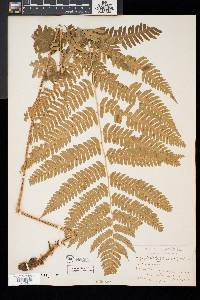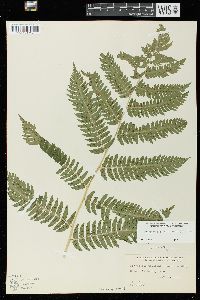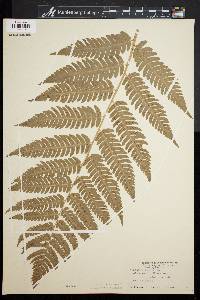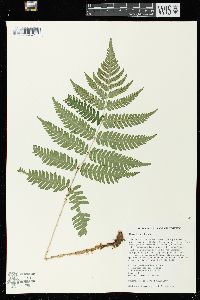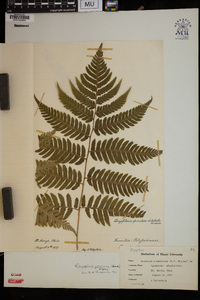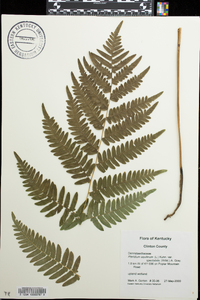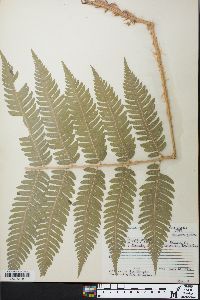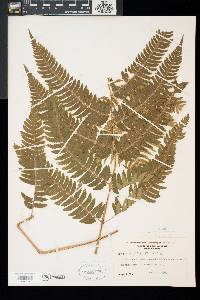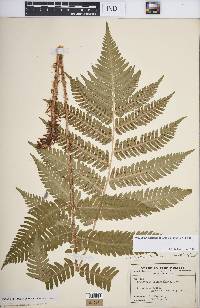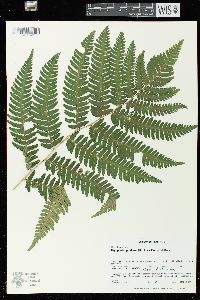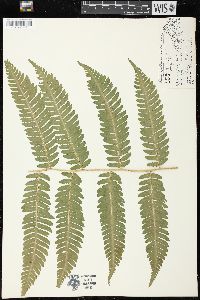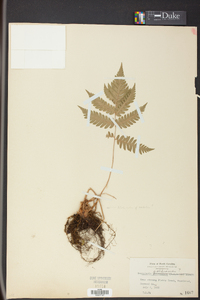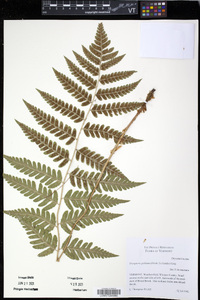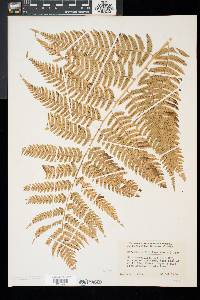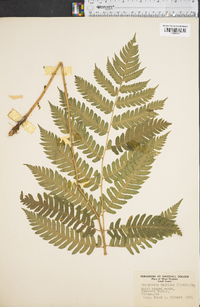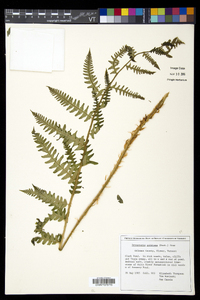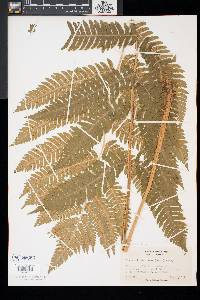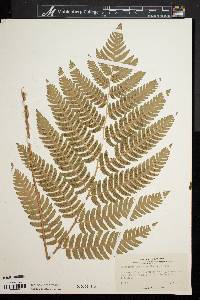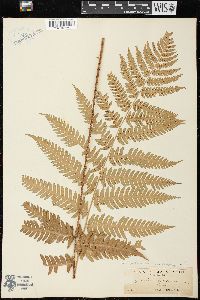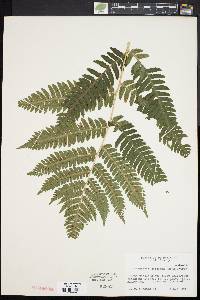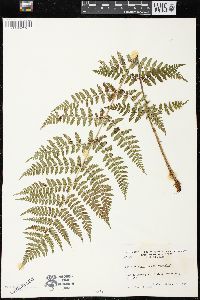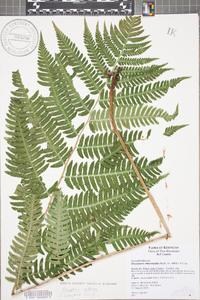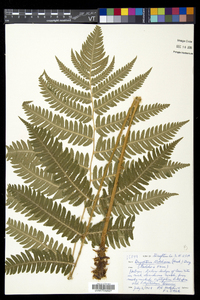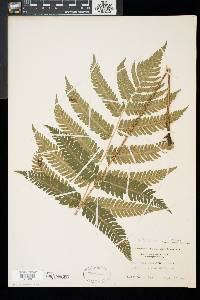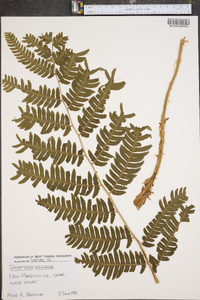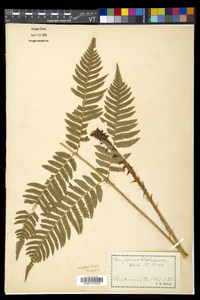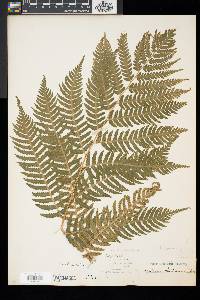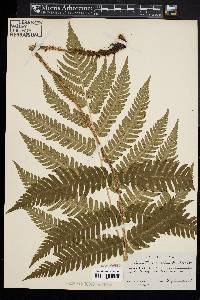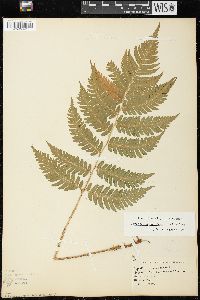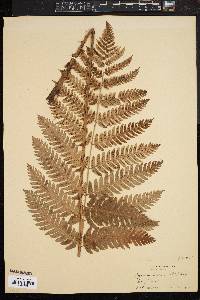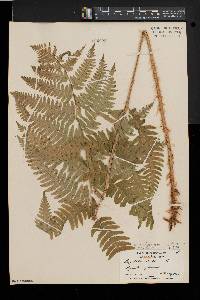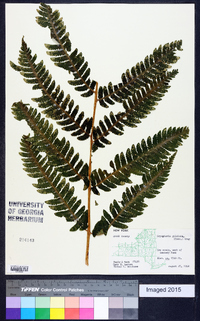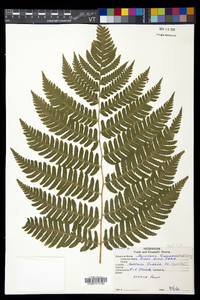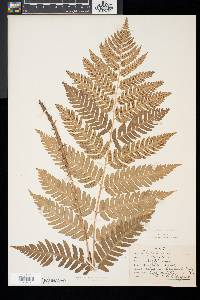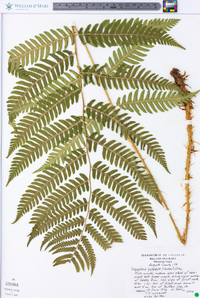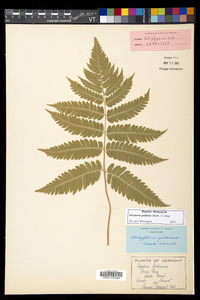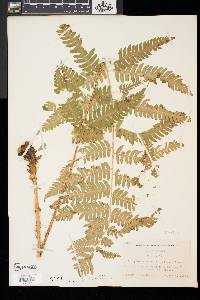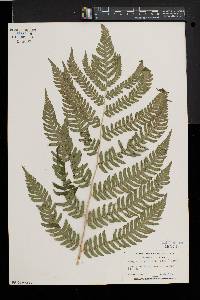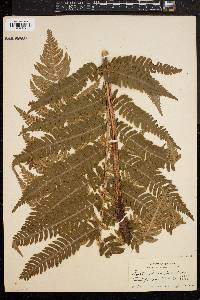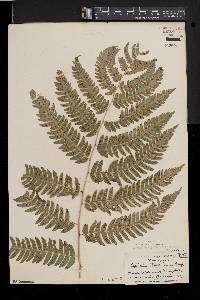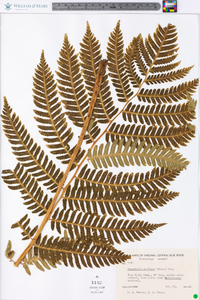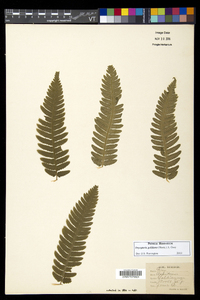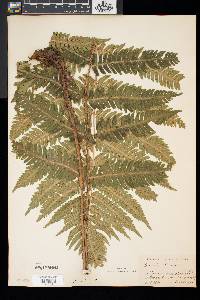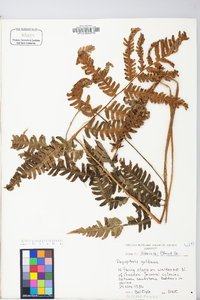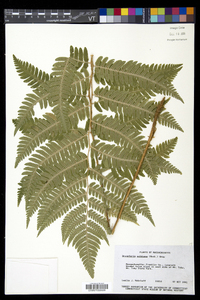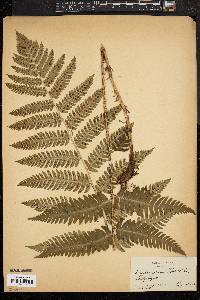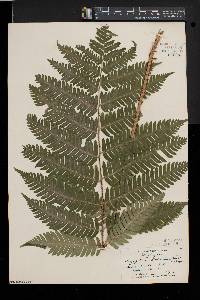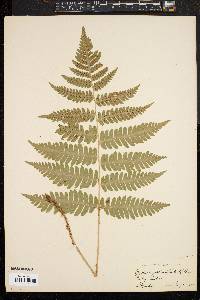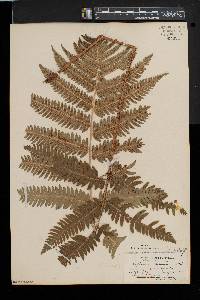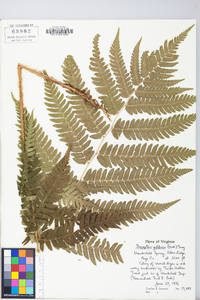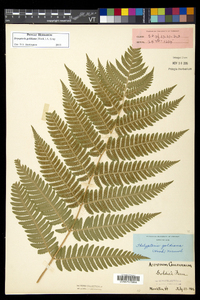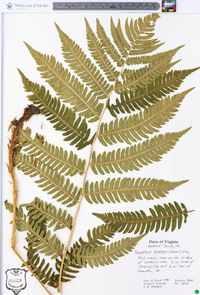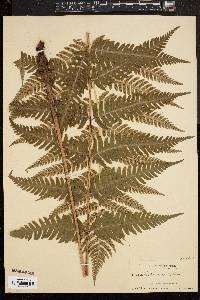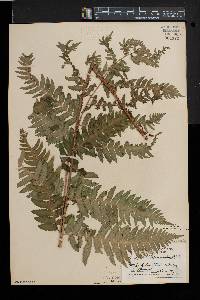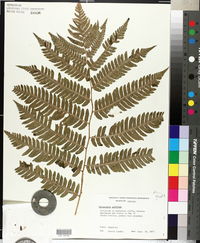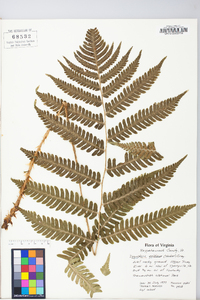
|
Dryopteris goldieana (Hook. ex Goldie) A. Gray
 (redirected from: Dryopteris goldiana (Hook. ex Goldie) A. Gray) (redirected from: Dryopteris goldiana (Hook. ex Goldie) A. Gray) |
|
|
Family: Dryopteridaceae
Goldie's Wood Fern, more...Goldie
[Aspidium goldianum Hook., moreAspidium goldieanum , Dryopteris goldiana (Hook. ex Goldie) A. Gray, Thelypteris goldiana Nieuwl.] |
Leaves monomorphic, dying back in winter, 35--120 × 15--40 cm. Petiole 1/3 length of leaf, scaly at base; scales scattered, dark, glossy brown to nearly black, with pale border. Blade green, often white-mottled at tip, ovate, tapering abruptly at apex, pinnate-pinnatifid to 2-pinnate at base, herbaceous, not glandular. Pinnae parallel to plane of blade, ovate-lanceolate, broadest above base; basal pinnae broadly oblong-lanceolate, slightly reduced, basal pinnule equal to adjacent pinnules, basal basiscopic pinnule and basal acroscopic pinnule equal; pinnule margins crenulate or serrate. Sori nearer midvein than margin. Indusia and axes lacking glands. 2 n = 82. Dense, moist woods, especially ravines, limey seeps, or at the edge of swamps; 50--1500 m; N.B., Ont., Que.; Ala., Conn., Del., Ga., Ill., Ind., Iowa, Ky., Maine, Md., Mass., Mich., Minn., Mo., N.H., N.J., N.Y., N.C., Ohio, Pa., R.I., Tenn., Vt., Va., W.Va., Wis. Dryopteris goldiana is diploid and is one of the parents of D . celsa and of D . clintoniana . Dryopteris goldiana hybridizes with five species. Hybrids can be identified by the glossy dark scales and large blade size. A remarkable additional hybrid (× Dryostichum singulare W. H. Wagner), involving this species and Polystichum lonchitis , is known from Gray and Simcoe counties, Ontario. It is intermediate between the parents and is sterile (W. H. Wagner Jr., F. S. Wagner et al. 1992).
Perennial fern 0.8 - 1.4 m tall Leaves: clustered, stalked, green (often with white speckles at tip), deciduous (dying back in winter), 0.7 - 1 m long, 15 - 40 cm wide, in outline egg-shaped with abruptly tapered tip, but pinnately compound. The leaves are typically hairless on the upper surface, never glandular-hairy, but the lower surface of the main "midrib" (rachis) has sparse narrow scales, and a lengthwise groove along its upper surface. Rhizome: mostly ascending or erect, scaly. Leaf stalks: one-third length of blade (up to 40 cm), with many, 1 - 2 cm long, lance-shaped, long-pointed, dark, glossy brown to nearly black, pale bordered scales at base. Spores: 64 per sac, brownish, all of one kind, single-sectioned (monolete), oblong or kidney-shaped, and coarsely wrinkled or with folded wings. The spores give rise to the gametophyte (the sexual phase of the plant), which is small, green, heart-shaped, hairless or often with glands or hairs, and sits above the ground. Similar species: Dryopteris goldiana is most similar to D. celsa, a fertile hybrid of this species and D. ludoviciana, but the hybrid differs by having leaf blades that are more gradually tapered to the tip, the lowest pair of divisions (pinnae) are usually shorter than those just above them, and the spore clusters (sori) are about midway between the midvein and edges of the pinnae segments. Another fertile hybrid of this species (with D. cristata) is D. clintoniana, which can be distinguished by having more triangular-shaped lower pinnae that are typically under 10 cm long, and the scales at the base of the leaf stalks are tan. Also very similar is D. cristata, but it too has more triangular pinnae, tan scales, and the lowest pinnae are usually under 5 cm long. Habitat and ecology: Somewhat rare, usually in beech-maple and maple-basswood forests in our eastern counties, also in moist springy ground, ravines, limey seeps, or edges of swamps. Occurence in the Chicago region: native Notes: This species is one of the parents of both D. celsa and D. clintoniana. It hybridizes with five different species, but can always be distinguished by the glossy dark scales at the leaf stalk base, and the large leaf blades. In addition to hybridizing with other species of Dryopteris, this species can also hybridize with a species in a separate genus, Polystichum lonchitis, to create the sterile taxon X Dryostichum singulare, which occurs in Ontario. Etymology: Dryopteris is from the Greek drys (oak), and pteris (fern) referring to the plant's habitat. Goldiana is named after its discoverer, botanist John Goldie, 1793 - 1886. Author: The Field Museum Rhizome mostly ascending or erect; lvs semi- evergreen, 7.5-12 dm, the petiole to 4 dm, densely scaly at the base, the subentire scales 1-2 cm, lance- attenuate, tending to be dark brown medially and paler marginally; blade ovate, 2-3.5 dm wide, abruptly acuminate, not much narrowed below, pinnate-pinnatifid, eglandular, the rachis and costae with some pale narrow scales; pinnae 12-16 pairs below the pinnatifid tip, oblong-lanceolate, mostly 3-4.5 cm wide, subsessile, the larger ones with 15-20 pairs of segments, the larger segments 15-30 נ6-9 mm, incurved- serrate or -biserrate, the teeth spinulose; lower basal segment of the lowest pinna shorter than the second segment; veins mostly 7-10 pairs per segment, mostly twice-forked, sori near the midvein of the segments; 2n=82. Moist woods in rich circumneutral soil; N.B. to s. Ont. and Minn., s. to S.C., n. Ga., Tenn., and Io. A rare hybrid with Polystichum lonchitis in Ont. has been named Dryostichum سimpsonii W. H. Wagner. Gleason, Henry A. & Cronquist, Arthur J. 1991. Manual of vascular plants of northeastern United States and adjacent Canada. lxxv + 910 pp. ©The New York Botanical Garden. All rights reserved. Used by permission. From Flora of Indiana (1940) by Charles C. Deam Infrequent to rare throughout the state in deep humus, usually on the slopes of wooded ravines. ...... Indiana Coefficient of Conservatism: C = 9 Wetland Indicator Status: FAC |
